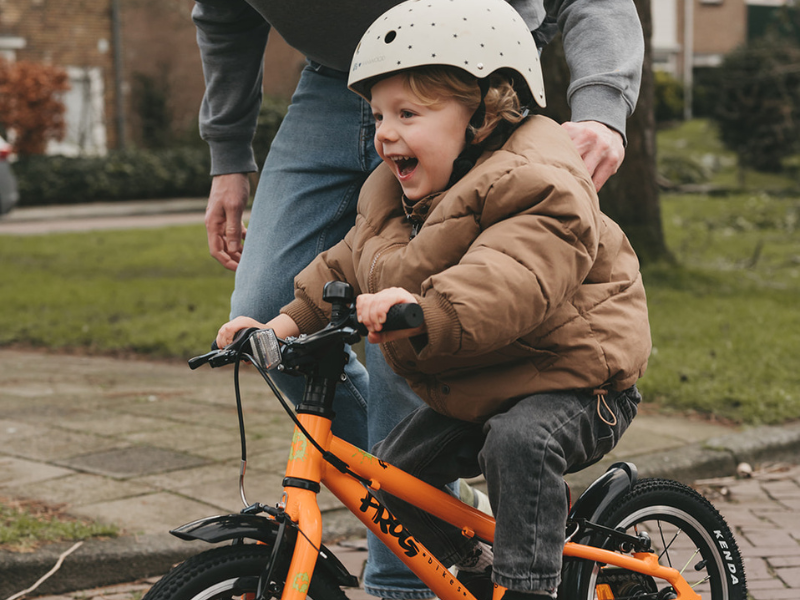Top 10 tips for kids learning to ride a bike
- 17 Oct 2022

How wonderful is it to stop and watch children riding past on their bikes with such confidence… We often wonder how long they have been riding.
The time it takes for children to feel confident on two wheels could be a day, a week, or even months. It’s essential to let kids practice cycling time and time again but also allow them a break if they feel overwhelmed.
What are the 4 essential things to consider when learning to ride a bike?
When it comes to cycling there are 4 key things to consider before you set your child off on their journey:
1) Balance - ensure they feel confident and comfortable
2) Steering - being in control of which way they are heading
3) Pedalling - basic understanding and knowledge of how to pedal and the ability to shift their weight
4) Braking - learn to stop before they start, this will make them feel confident that they have control
Based on your child's interests and physical condition, the typical age at which children begin learning to ride a bike is between 5 and 7 years old. However, these figures are merely average, and your child might be prepared to start learning sooner.
We take a look at the top 10 tips for kids learning to ride a bike:


1. Safety First
Always ensure your child’s bike and equipment are set up properly before they start cycling. You should ensure you have all the equipment they need and if their bike is second-hand, giving the bike a once over using the M-Check is advisable.
Wearing the correct helmet is highly recommended, and never buy a second-hand helmet as it could have been previously damaged. Ensuring that the helmet fits correctly is very important. Check out how to fit a kid’s bike helmet here.
If your child is under 2 years old, a balance bike is a great way to help them feel in control and comfortable with balancing.
Another safety element is checking that your child is on the correct bike size. You can check sizes using our Frog Fitting Guide to get an idea of what model size your child should be on. We recommend sizing by leg length rather than age, as this is the most reliable way of getting the right size of bike for each child. Age alone isn’t a reliable measure as there is a large spread of “normal” leg lengths & heights for each age.
“My top tip would be to use the Frog Fitting Guide to ensure that your child assumes a comfortable, ergonomic, and safe riding position. Our components have standard dimensions, so stems, seat posts, cranks, and handlebars can be easily changed if required…” Dr. Tom Korff - Head of R&D.


2. Check the seat height and adjustment
It’s important that you check the height of your child’s seat. Ask your child to stand next to their bike and check the seat is at hip height. Check out our blog on the adaptability of Frog Bikes for guidance.
Quick-release saddles make it very simple to adjust on the go without the need for any tools. The saddle’s distance and angle can also be adjusted to suit the child’s individual needs.
It is important to adopt a good riding position from an early age. Ensure a comfortable riding position with the pelvis tilted slightly forward. A forward-tilted pelvis can help reduce the pressure on the child’s lower back. It also creates a small amount of pressure between hands and handlebars, which gives the child greater steering control and a more stable and enjoyable ride.


3. Learn to balance without pedals
Balance is key to getting your child cycling and a balance bike is where a child’s cycling journey begins. These lightweight, pedal-less bikes help children develop the necessary balance to then learn how to cycle, and there is absolutely no need for training wheels. Boosting kids’ confidence with balance bike training is a great way of starting their cycling journey.
There are a variety of balance bikes available in all sorts of exciting colours.
As a result, kids will become more accustomed to the motion of biking and develop their speed and balance. Once they've mastered that, you can introduce the pedals and teach them how to utilise them properly.
“We also used a 'grab handle' vest for both Mia and Oliver (BikyBiky vest) which meant that we were able to follow behind holding onto them without affecting their own balance skills. Holding an arm or shoulder may mean that you unintentionally pull or push the child rather than letting them find their comfortable balance point.” Dan - Super Dad to Mia, and Oliver- Frog Bikes Ambassadors
“Alfie has been riding a balance bike competently since around 18 months and at the age of 2, he is already asking for pedals. Although he’s not quite ready yet we offer him the chance to sit on the bike and practice the momentum, just as we did his brother and we’re sure when the time is right there will be no stopping him!" Amy- Frog Ambassador Mum of two energetic boys.


4. Figure out the brakes without falling
When teaching your child to ride a bike, ensuring that they understand how brakes work is paramount.
Get your child to always cover their brakes (usually with two or three fingers on each brake lever). It's very important for beginners to form this habit because it saves a minute or two when they need to stop or slow down. Games and role play are effective ways to motivate kids. "Red Light, Green Light" role play is a great way to get them going. Variate the distances and promote quicker stops. An alternative option is to put safety cones on the ground 10 to 20 feet ahead of your child, telling them to stop before they hit the cone. This will not only offer them the ability to brake when needed but also boost their confidence.
“Our number one tip was to keep your head up and look where you want to go. Also, I know it’s not one for actually getting motion but one of the first things we did was play a game around using the brake so that she was confident at using it and actually stopping. (-scary how many balance bikes are brakeless - Not Frog though!!)” Rob - Trail chasing Dad of two girls.


5. Choose a safe area to learn
Choose a safe, open environment, such as a park or playground, when you and your child are prepared to begin learning how to ride a bike. They will have plenty of room to practice without being concerned about vehicles or other hazards.
Take a look for local open areas or great places to utilise whilst on a family holiday. Cycling should be an adventure and fun and finding a suitable place for a family bike ride is key to building confidence.
“When learning to ride, both Mia and Oliver learned on the large concrete playground area at the local school. This was great as it was very rarely busy and meant no obstacles to ride into (also helps stop target fixation if you don't have anything to avoid). Another bonus was that there was an ever so slight slope to the playground, this helped them keep a bit of speed when learning which in turn helped keep the bike more stable.” Dan, Mia, and Oliver’s Dad- Frog Bikes Ambassadors who love the outdoors.


6. Learn Together
Are you a little rusty from being out of the saddle for a while, or have you never learned how to ride a bike? Why not practice with the kids and get all the family cycling.? In addition to giving you the chance to spend time with your family, it may also speed up the kids' progress. Bringing siblings or friends along can also be beneficial, as little ones tend to always want to be able to do what the bigger ones are doing, a great incentive to get pedalling faster! But, remember to always make learning to cycle fun, and never a chore!
“Alfie has always been inspired by his older brother and his friends. From our experience, it’s good to be around others who ride so there is someone to learn from, but also someone to challenge you to do that little bit more.” Amy- Frog Ambassador Mum of two energetic boys


7. Take Breaks
Learning to ride a bike can be exhausting for a child. They will not only be using physical strength but also their mental strength to hone their skills properly. We always recommend making sure they get a good break when either learning to ride or when they start their first cycling journeys.
A good snack break or visit to the local park can be nice downtime away from their wheels to recharge their little arms, legs, and mind. Even a short stop to view their surroundings can be all the break they need.


8. Repeat and Reward
Repeat the above steps as many times as necessary for your child to gain the confidence to ride without your assistance. And don’t forget regular and continued praise for every small achievement during the learning process.
“One of the phrases we use in our house is “practice makes progress”. Time on a bike and making it fun makes all the difference.” Amy- Frog Ambassador Mum of two energetic boys
Get some stickers or small incentives to keep them encouraged to keep on learning. Our Frog Ambassador Mia loves hot chocolate with marshmallows.
“I used to cycle short distances with my kids, my youngest used to have meltdowns over not being able to keep up or pedalling and falling over. I would always encourage her and promise to get a hot chocolate with marshmallows if she passed Eton Bridge. It worked every time.” Amarjit Kaur Multani- Frog Bikes Marketing Executive


9. Consider bike skill courses
Whatever your age, learning to cycle opens up a world of opportunities! Cycling keeps us fit, reduces our carbon footprint, and helps us look after our mental well-being. From cycling to school or work to avoid getting stuck in traffic, to replacing short car journeys with cycling to help save the planet. Learning to cycle is an essential life skill, and here’s a great way to get started!
If you do need that extra support then consider some bike courses which will give you that extra boost to aid you in riding.


10. Safety first and last
Again, we cannot reiterate enough the importance of safety! The most important thing to keep in mind when teaching your child to ride a bike is that safety comes first.
Before letting them depart, double-check that they are wearing helmets and that the area is clear of traffic. Once they start cycling on their own, they will enforce these restrictions and the value of riding safely.
Tag us so that we can follow your cycling adventure @frogbikes #frogbikes!
Practice makes perfect….. good luck with your cycling!







